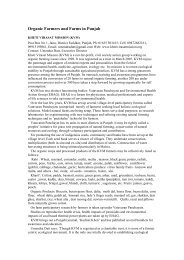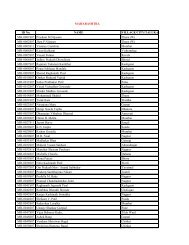Western Ghats Kokum Foundation - Organic Farming Association of ...
Western Ghats Kokum Foundation - Organic Farming Association of ...
Western Ghats Kokum Foundation - Organic Farming Association of ...
Create successful ePaper yourself
Turn your PDF publications into a flip-book with our unique Google optimized e-Paper software.
An Introduction to <strong>Kokum</strong><br />
<strong>Kokum</strong> (Garcinia indica Choisy) is one <strong>of</strong> the native underexploited tree spice. It is<br />
mostly found in Konkan region <strong>of</strong> Maharashtra, Goa, Karnataka, Kerala and Surat district <strong>of</strong><br />
Gujarat on the West Coast <strong>of</strong> India and to some extent in the forests <strong>of</strong> Assam, Meghalaya,<br />
West Bengal. In spite <strong>of</strong> its incredible medicinal and nutritive properties, kokum is<br />
generally not cultivated systematically on orchard scale like that <strong>of</strong> mango, cashew nut etc.<br />
It is mostly found as a kitchen garden plant or mixed crop in plantations <strong>of</strong> coconut, areca<br />
nut, as roadside plants or in forest.<br />
The common names for <strong>Kokum</strong> are Goa butter tree, <strong>Kokum</strong> butter tree, mangosteen<br />
oil tree. In Hindi it is known as <strong>Kokum</strong> while in Marathi it is variously known as bheranda<br />
bhiranda, kokamba, kokambi, ratamba, ratambi, tambada amba. In Tamil it is known as<br />
murgal, murgal-mara and in Malayalam it is kaattampi kokkam in Kannada it is called<br />
murgina, punarpuli, devana huli. In Oriya it is tintali and in Gujarati and Konkani it is Kokam<br />
or bhirind. In Sanskrit it is variously known as vrikshamia, amlabija, amlapura, amlashaka.<br />
In French, Italian and Spanish the name is spelt as cocum and in Portuguese it is known as<br />
brindao or brindonna.<br />
<strong>Kokum</strong> is a tropical evergreen tree, related to the mangosteens. A slender tree with<br />
sloping branches, it reaches heights <strong>of</strong> 15m (50 ft). The thin bark is lined and the leaves<br />
1/2<br />
oblong. The dark purple fruit is round, about 4 cm (1 in) in diameter with 5 - 8 seeds. The<br />
fruits are picked when ripe, the rind is then removed and soaked in the juice <strong>of</strong> the pulp and<br />
then sun-dried. The kokum was hitherto difficult to cultivate, usually growing as solitary<br />
trees in a tropical forest environment<br />
<strong>Kokum</strong> flourishes very well up to an elevation <strong>of</strong> about 800 m from MSL. It requires<br />
warm and humid tropical climate. It thrives well in coastal areas receiving over 250 cm <strong>of</strong><br />
rainfall. It grows well in lateritic, alluvial soils having depth <strong>of</strong> 1.0 m and pH <strong>of</strong> 6.7. The<br />
locations where coconut and arecanut can be cultivated are suitable for kokum. Though<br />
kokum can be cultivated as a rainfed crop, it can not be cultivated on hill tops like mango or<br />
cashewnut. It can be grown as a monocrop or as a mixed crop in established coconut and<br />
arecanut plantation. <strong>Kokum</strong> plants respond well to irrigation during summer. Ripe kokum<br />
fruits harvested during April-May from a region/ locality and pool the produce at one point<br />
for processing. Value added products like salted juice (agal), syrup (amrut) or dried rind<br />
are prepared.<br />
The precise statistics regarding area production and productivity is not available as<br />
kokum is not planted in an organized manner. As per a base line survey in 2010, kokum is<br />
grown on about 1000 ha area in the Konkan region with production <strong>of</strong> about 4500 MT<br />
fruits. According to the survey conducted earlier by Chief Conservator <strong>of</strong> Forest out <strong>of</strong> the<br />
total 46,600 <strong>Kokum</strong> trees in the state <strong>of</strong> Maharashtra; 43,000 trees existed in Ratnagiri and<br />
Sindhudurg Districts. It was also reported that in South Konkan 1674 MT <strong>of</strong> <strong>Kokum</strong> fruits<br />
were used for production <strong>of</strong> dried <strong>Kokum</strong> rind, 757 MT for preparation <strong>of</strong> <strong>Kokum</strong> syrup and<br />
40MT for manufacture <strong>of</strong> <strong>Kokum</strong> butter. Research on production technology for <strong>Kokum</strong> is<br />
being conducted at Dr. B. S. Konkan Krishi Vidyapeeth, Dapoli, Maharashtra, ICAR Research<br />
6<br />
Resource Book on <strong>Kokum</strong> (Garcinia indica Choisy)<br />
<strong>Western</strong> <strong>Ghats</strong> <strong>Kokum</strong> <strong>Foundation</strong>, Panaji - Goa





